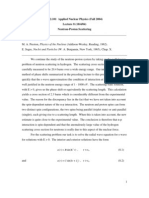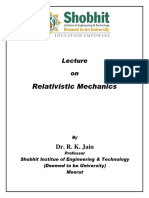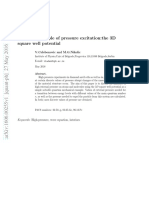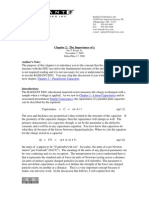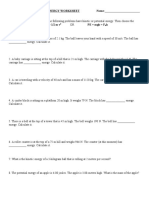Tensors, Stress, Strain, Elasticity
Tensors, Stress, Strain, Elasticity
Uploaded by
Siti Cweety MarryCopyright:
Available Formats
Tensors, Stress, Strain, Elasticity
Tensors, Stress, Strain, Elasticity
Uploaded by
Siti Cweety MarryOriginal Description:
Copyright
Available Formats
Share this document
Did you find this document useful?
Is this content inappropriate?
Copyright:
Available Formats
Tensors, Stress, Strain, Elasticity
Tensors, Stress, Strain, Elasticity
Uploaded by
Siti Cweety MarryCopyright:
Available Formats
Tensors, Stress, Strain, Elasticity
1 of 10
http://serc.carleton.edu/NAGTWorkshops/mineralogy/mineral_physics...
Tensors: Stress, Strain and Elasticity
by Pamela Burnley, University of Nevada Las Vegas
Outline
Introduction
The Stress Tensor
The Strain Tensor
Elasticity
Literature
Introduction
Many physical properties of crystalline materials are direction dependent because the arrangement of the atoms in the crystal lattice are different in different directions.
If one heats a block of glass it will expand by the same amount in each direction, but the expansion of a crystal will differ depending on whether one is measuring
parallel to the a-axis or the b-axis. For this reason properties such as the elasticity and thermal expansivity cannot be expressed as scalars. We use tensors as a tool to
deal with more this complex situation and because single crystal properties are important for understanding the bulk behavior of rocks (and Earth), we wind up dealing
with tensors fairly often in mineral physics.
What is a Tensor
A tensor is a multi-dimensional array of numerical values that can be used to describe the physical state or properties of a material. A simple example of a
geophysically relevant tensor is stress. Stress, like pressure is defined as force per unit area. Pressure is isotropic, but if a material has finite strength, it can support
different forces applied in different directions. Figure 1 below, illustrates a unit cube of material with forces acting on it in three dimensions. By dividing by the surface
area over which the forces are acting, the stresses on the cube can be obtained. Any arbitrary stress state can be decomposed into 9 components (labeled ij). These
components form a second rank tensor; the stress tensor (Figure 1).
Tensor math allows us to solve
problems that involve tensors. For
example, let's say you measure the
forces imposed on a single crystal in
a deformation apparatus. It is easy to
calculate the values in the stress
tensor in the coordinate system tied
to the apparatus. However you may
be really interested in understanding
the stresses acting on various
crystallographic planes, which are
best viewed in terms of the
crystallographic coordinates. Tensor
math allows you to calculate the
stresses acting on the
crystallographic planes by
transforming the stress tensor from
one coordinate system to another.
Another familiar tensor property is
electrical permittivity which gives
rise to birefringence in polarized light
Figure 1
microscopy. You are probably
familiar with the optical indicatrix which is an ellipsoid constructed on the three principle refractive indices. The refractive index in any given direction through the
crystal is governed by the dielectric constant Kij which is a tensor. The dielectric constants "maps" the electric field Ej into the electric displacement Di :
Were k0 is the permitivity of a vacuum. Di can be calculated from Ej as follows:
D1 = koK11E1 + koK12E2 + koK13E3
D2 = koK21E1 + koK22E2 + koK23E3
20/10/2015 8:20
Tensors, Stress, Strain, Elasticity
2 of 10
http://serc.carleton.edu/NAGTWorkshops/mineralogy/mineral_physics...
D3 = koK31E1 + koK32E2 + koK33E3
So you can see that even if E1 is the only non-zero value in the electric field, all the components of Di may be non-zero.
Rank of a Tensor
Tensors are referred to by their "rank" which is a description of the tensor's dimension. A zero rank tensor is a scalar, a first rank tensor is a vector; a one-dimensional
array of numbers. A second rank tensor looks like a typical square matrix. Stress, strain, thermal conductivity, magnetic susceptibility and electrical permittivity are all
second rank tensors. A third rank tensor would look like a three-dimensional matrix; a cube of numbers. Piezoelectricity is described by a third rank tensor. A fourth
rank tensor is a four-dimensional array of numbers. The elasticity of single crystals is described by a fourth rank tensor.
Tensor transformation
As mentioned above, it is often desirable to know the value of a tensor property in a new coordinate system, so the tensor needs to be "transformed" from the original
coordinate system to the new one. As an example we will consider the transformation of a first rank tensor; which is a vector. If we have a vector P with components
p1, p2, p3 along the coordinate axes X1, X2, X3 and we want to write P in terms of p1, p2, p3 along new coordinate axes Z1, Z2, Z3, we first need to describe how the
coordinate systems are related to each other. This can be done by noting the angle between each axis of the new coordinate system and each axis of the new coordinate
system; altogether there will be 9 angles, three of which are illustrated in Figure 2:
Figure 2
We can then express p1, p2,and p3 in terms of p1, p2, and p3:
Figure 3
p1 = p1cos 11 + p2cos 12 + p3cos 13
p2 = p1cos 21 + p2cos 22 + p3cos 23
20/10/2015 8:20
Tensors, Stress, Strain, Elasticity
3 of 10
http://serc.carleton.edu/NAGTWorkshops/mineralogy/mineral_physics...
p3 = p1cos 31 + p2cos 32 + p3cos 33
To abbreviate, we replace the cos with "a" (e.g cos21 = a21) and notice that each equation can be rewritten as:
which can be further condensed to:
If we utilize Einstein's summation convention, we can leave out the summation symbol and get:
(1) pi = aijpj (i,j = 1, 2, 3) .
There is a similar process for transforming a second rank tensor, but calculating a formula for the transformation by the same means that we transformed the vector
above would be quite laborious. There is a more convenient shortcut. Just as the dielectric constants "maps" the electric field Ej into the electric displacement Di, we
can imagine a second rank tensor Tkl that takes Ql and produces Pk in a given coordinate system:
(2) Pk =TklQl
We want to find the values for this second rank tensor in a new coordinate system. In the new coordinate system this tensor, Tij will produce Pi from Qj, where Pi and
Qj are the transformed versions of Pk and Ql.
(3) Pi=TijQj
We already know how to transform Pi into Pk:
(4) Pi = aikPk
and since
(5) Pk = TklQl
(6) Pi = aik TklQl
To transform Qjto Ql we need only to realize that the direction cosines to go from the new coordinate system back to the old coordinate system are the same as those
used to go from old to new, except the indices will be reversed. So:
(7) Ql= ajlQj
which we can then substitute into the equation above and get
(8) Pi = aikTklajlQj
20/10/2015 8:20
Tensors, Stress, Strain, Elasticity
4 of 10
http://serc.carleton.edu/NAGTWorkshops/mineralogy/mineral_physics...
The tensor we are looking for is Tij:
(9) Pi = TijQj
Substituting (9) into the left hand side of (8) and dividing by Qj we get
(10) Tij = aikajlTkl
The Identity Tensor
A valuable tool in tensor math is the identity tensor, which is referred to as the Kronecker delta:
It is abbreviated as:
The Stress Tensor
Stress is defined as force per unit area. If we take a cube of material and subject it to an arbitrary load we can measure the stress on it in various directions (figure 4).
These measurements will form a second rank tensor; the stress tensor.
Figure 4
20/10/2015 8:20
Tensors, Stress, Strain, Elasticity
5 of 10
http://serc.carleton.edu/NAGTWorkshops/mineralogy/mineral_physics...
The Eigen values of ij ; represented as 1 , 2 , 3 are referred to as the principle stresses.
The Eigen vectors are the principle stress directions known as the maximum, intermediate and minimum principle stresses respectively; in geology compression is
considered positive and the maximum compressive stress is referred to as 1. However, in engineering and physics, tension is considered positive so the maximum
compressive stress is referred to as 3. Therefore, it is important to be aware of which sign convention is being used. A cube with its edges parallel to the principle
stress directions experiences no sheer stresses across its faces.
An important property of the stress tensor is that it is symmetric:
ij = ji
Intuitively, this can be seen if one images shrinking the cube in Figure 4 to a point. If the cube is infinitesimally small, the forces across each face will be uniform. If
the cube is to remain stationary the normal forces on opposite faces must be equal in magnitude and opposite in direction and the shear tractions which would tend to
rotate it must balance each other. So for example, if 13 is not equal in magnitude to 31,the cube will spin around the X2 direction. Therefore, it is only necessary to
find 6 of the components of the tensor.
Important concepts are often used are deviatoric stress and hydrostatic pressure. Any stress tensor may be broken into two parts
where
p = ( 11 + 22 + 33 ) / 3)
Using the Kronecker delta notation this may be written as
ij = ij(dev) + pij .
The Strain Tensor
20/10/2015 8:20
Tensors, Stress, Strain, Elasticity
6 of 10
http://serc.carleton.edu/NAGTWorkshops/mineralogy/mineral_physics...
Strain is defined as the relative change in the position of points within a body that has undergone deformation. The classic example in two dimensions is of the square
which has been deformed to a parallelepiped.
Let us examine the movement of a point on the corner of the square (m) which moves to (m'):
In order for this analysis to work we must only consider infinitesimally small strains. We will call the original length of the side of the square X1. We will call the
component of the displacement (d) of m to m' resolved onto the X1 axis d1and the amount of the the component of d resolved onto the X2 axis d2.A simple way to
measure the strain would be to compare d1 with X1 and d2 with X1, etc.
We can represent this quantity by e11
or more generally:
Since d2 is very small ,
(d2/X1) (d2/(X1 + d1)) = tan.
For very small angles tan = and therefore e21 = . Now imagine that instead of being deformed, the initial square had been simply rotated around the origin, the
20/10/2015 8:20
Tensors, Stress, Strain, Elasticity
7 of 10
http://serc.carleton.edu/NAGTWorkshops/mineralogy/mineral_physics...
values eij ij would still be non-zero. For this reason, strain is characterized by a tensor ij from which the rigid body rotation has been subtracted. Therefore we can
write:
ij = eij - ij
where ij is the rigid body rotation and ij is defined as the strain.
ij = (eij + eji)
ij = (eij eji)
For the two-dimensional case:
ij is a symmetric tensor and ij is an antisymmetric tensor; the leading diagonal ofij is always zero.
The tensor ij has Eigen values which are called the principal strains (1, 2, 3). The Eigen vectors lie in the three directions that begin and end the deformation in a
mutually orthogonal arrangement. If the Eigen vectors are initially of length 1 then in the end they are length:
1 + i.
Strain lends itself well to geometric representation. Think of a unit sphere which has been deformed. By inspection, one could find the three orthogonal directions that
have remained orthogonal in the deformation. The length of radial lines parallel to those orthogonal directions (X1, X2, X3) will have changed length such that:
X1' = X1(1 + 1)
X2' = X2(1 + 2)
X3' = X3(1 + 3).
If we substitute the new dimensions into the equation for the sphere in this particular reference frame:
X12 + X22 + X32 = 1 .
We get
(X1' 2)/(1 + 1)2 + (X2' 2)/(1 + 2)2 + (X3' 2)/(1 + 3)2 = 1
This is the equation of an ellipsoid, which is called the strain ellipsoid. Often geologists will use statistical studies of the shapes of pebbles, certain types of sand
particles, and other natural objects which were probably originally round, to determine the strain which a particular body of rock has undergone.
Elasticity
Unlike stress and strain, elasticity is an intrinsic property of a material. The elastic properties of Earth materials affects everything from the variation of density with
depth in the planet to the speed at which seismic waves pass through the interior. Ultimately the elastic properties of a material are governed by the arrangement and
strength of the bonds between the atoms that make up the material. Elasticity is the property of "reversible deformation". If the deformation in a body under stress does
not exceed a certain limit, called the elastic limit, the body will return to its initial shape when the stress is removed. If the amount of stress () is infinitesimaly small
then the amount of strain (), which is also infinitesimal, is linearly proportional to the strain and may be written as:
= s
20/10/2015 8:20
Tensors, Stress, Strain, Elasticity
8 of 10
http://serc.carleton.edu/NAGTWorkshops/mineralogy/mineral_physics...
or
= c
Where s is the elastic compliance and c is the elastic stiffness. In order to relate two second rank tensors, a fourth rank tensor is necessary.
ij = sijkl kl
or
ij = cijkl kl
To calculate ij for the three-dimensional case we would begin like so:
11 = S111111 + S111212 + S111313 + S112121 + S112222 + S112323 +
S113131 + S113232 + S113333
Notice that even if all ij = 0 except 11, that most ij 0 . This can be seen if you take a square and pull on it from only one direction;
Figure 5
it strains in all directions.
For the three-dimensional case there are 81 terms in a fourth rank tensor. However, both stress and strain are symmetric tensors; ij = ji and ij = ji each only has 6
independent terms. There are only 6 equations needed to calculate ij from ij and in each equation there will only be 6 independent terms. Therefore, there can be no
more than 36 independent values in Sijkl. For convenience, a matrix notation is used. The subscript is broken into two parts:
Sij.kl
and abbreviated as follows:
To avoid the appearance of factors in the equations, the following factors are introduced into the matrix notation:
Sijkl = Smn for m, n = 1, 2, or 3
2Sijkl = Smn for m or n = 4, 5, or 6
4Sijkl = Smn for m and n = 4, 5, 6
2ij = m for m = 4, 5, or 6
In matrix notation the equation for obtaining strain from stress is:
20/10/2015 8:20
Tensors, Stress, Strain, Elasticity
9 of 10
http://serc.carleton.edu/NAGTWorkshops/mineralogy/mineral_physics...
i = Sijj ( i,j = 1, 2, . . . 6)
and stress from strain is:
i = Cijj ( i,j = 1, 2, . . . 6)
The compliances and stiffnesses are written as an array; for example for Sij
As I mentioned above, ij and ij are symmetric and therefore the number of independent coefficients is reduced from 81 to 36. Because of "compatibility relations,"
which say that material will deform continuously, the number is reduced to 21. If the material being deformed is symmetric the number of coefficients is even further
reduced. For an isotropic material, one that behaves the same in any orientation, there are only two quantities necessary. These are Young's Modulus E, and G the Shear
Modulus; all the coefficients may be expressed in terms of them.
S11 = 1/E
2(S11 - S12) = 1/G
Or alternatively,
S12 = /E
where is Poisson's Ratio
= (E/2G) 1.
Therefore, for an isotropic material:
1 = (1/E)(1 (2 + 3))
2 = (1/ E)(2 (1 + 3))
3 = (1/ E)(3 (2 + 1))
4 = (1/G)4
5 = (1/ G)5
6 = (1/ G)6
From these equations it becomes obvious that for isotropic materials the directions of the principal stresses are the same as those for the principal strains. If a
20/10/2015 8:20
Tensors, Stress, Strain, Elasticity
10 of 10
http://serc.carleton.edu/NAGTWorkshops/mineralogy/mineral_physics...
polycrystalline rock is large compared to the size of its constituent grains and does not have a preferred crystallographic orientation it will in general behave as an
isotropic solid.
Elastic Constants
As mentioned above, the number of elastic constants needed to describe the elastic response of a crystal depends on its symmetry. Cubic crystals require three elastic
constants: c11,c12 and c44. Hexagonal crystals require five and trigonal and tetragonal crystals require six or seven depending on the point group. Orthorhombic crystals
require nine constants and monoclinic crystals require thirteen. The elastic constants are affected by the state of the material including its temperature, and pressure and
for minerals with solid solutions, chemical composition as well.
After Nye, 1959
Additional Literature
Jaeger, J. C. Elasticity, Fracture and Flow. London: Chapman & Hall, 1969.
Jaeger, J. C.; Cook, N. G. W. Fundamentals of Rock Mechanics. London: Chapman & Hall,
1969.
Nye, J. F. Physical Properties of Crystals. London: Oxford University Press, 1959.
Bass, J.D. Elasticity of Minerals, Glasses, and Melts, Mineral Physics and Cyrstallography: A Handbook of Physical Constants, AGU Reference Shelf 2,T. J. Ahrens,
Ed., American Geophysical Union, Washington DC, 1995.
Acknowledgements
These materials are being developed with the support of COMPRES, the Consortium for Materials Properties Research in Earth Sciences, under NSF Cooperative
Agreement EAR 10-43050 and is partially supported by UNLV's High Pressure Science and Engineering Center, a DOE NNSA Center of Excellence supported under
DOE NNSA Cooperative Agreement No. DE FC52-06NA26274.
20/10/2015 8:20
You might also like
- Neutron Proton ScatteringDocument7 pagesNeutron Proton ScatteringDebayan DasguptaNo ratings yet
- Electromagnetic Fields and WavesDocument145 pagesElectromagnetic Fields and WavesDenisNo ratings yet
- Molecular Sieve Sizing Sheet PematangDocument8 pagesMolecular Sieve Sizing Sheet Pematangahmad santoso100% (1)
- TDP-102 ABCs of ComfortDocument71 pagesTDP-102 ABCs of ComfortErwin Maldo75% (4)
- Stress TensorDocument25 pagesStress TensorJsvijay KumarNo ratings yet
- Fea-Finite Element Analysis: Chapter-1 Stress TensorDocument106 pagesFea-Finite Element Analysis: Chapter-1 Stress Tensorkamsubh66No ratings yet
- Elasticity and EOSDocument15 pagesElasticity and EOSMSJEMNo ratings yet
- Bianchi Type-I, type-III and Kantowski-Sachs Solutions in F (T) GravityDocument8 pagesBianchi Type-I, type-III and Kantowski-Sachs Solutions in F (T) GravityManuel RodriguesNo ratings yet
- Matt Visser - Traversable Wormholes: Some Simple ExamplesDocument7 pagesMatt Visser - Traversable Wormholes: Some Simple ExamplesRtpomNo ratings yet
- Isotropic DefinitionDocument11 pagesIsotropic DefinitionAnaniah DuraiNo ratings yet
- AttachmentDocument11 pagesAttachmentThian Fang MingNo ratings yet
- pipkin1993Document17 pagespipkin1993Rodrigo Santos FerreiraNo ratings yet
- Carlos Barcelo and Matt Visser - Traversable Wormholes From Massless Conformally Coupled Scalar FieldsDocument11 pagesCarlos Barcelo and Matt Visser - Traversable Wormholes From Massless Conformally Coupled Scalar FieldsCoy668No ratings yet
- Relativistic Mechanics DR R K JainDocument16 pagesRelativistic Mechanics DR R K JainAnanta BiswasNo ratings yet
- 6 THDocument12 pages6 THalokkumar216No ratings yet
- RelativityDocument32 pagesRelativityCineva CindvaNo ratings yet
- Section 11 - Methods - For - Calculating - Band - Structure PDFDocument9 pagesSection 11 - Methods - For - Calculating - Band - Structure PDFMechWellNo ratings yet
- CH 3 The Wave Properties of ParticlesDocument16 pagesCH 3 The Wave Properties of ParticlesMariamawit BelayNo ratings yet
- Finite Element AnalysisDocument113 pagesFinite Element AnalysisTochi Krishna Abhishek57% (7)
- A Simple Example of Pressure Excitation-The 3D Square Well PotentialDocument7 pagesA Simple Example of Pressure Excitation-The 3D Square Well PotentialYashNo ratings yet
- Prpriedades FisicasDocument22 pagesPrpriedades FisicasAscanio BarbosaNo ratings yet
- Physics Questions ImportantsDocument130 pagesPhysics Questions Importantsblackbumber69No ratings yet
- الملزمة الرئيسية الفيزياء Document54 pagesالملزمة الرئيسية الفيزياء m4332060No ratings yet
- B. N. Chigarev: N.A.Kozyrev'S Causal Mechanics Seen by An Orthodox PhysicistDocument16 pagesB. N. Chigarev: N.A.Kozyrev'S Causal Mechanics Seen by An Orthodox PhysicistpdfscrNo ratings yet
- Quantum 1Document28 pagesQuantum 1dishant sarangalNo ratings yet
- XRD TheoryDocument7 pagesXRD TheoryAdarta Muh100% (1)
- Homework 1Document8 pagesHomework 1Alferid ShifaNo ratings yet
- Energy Momentum TensorDocument3 pagesEnergy Momentum Tensorrgkelly62No ratings yet
- INDACTIVWORKDocument9 pagesINDACTIVWORKNərgiz QasımovaNo ratings yet
- Tight BindingDocument5 pagesTight BindingalkeroneNo ratings yet
- Chapter 2: The Importance ofDocument8 pagesChapter 2: The Importance ofProsanta Kumar BiswasNo ratings yet
- Interatomic Potentials: Atoms Attract EaDocument9 pagesInteratomic Potentials: Atoms Attract EaDeri Andika BangunNo ratings yet
- ViscoelasticityDocument11 pagesViscoelasticitymchilwesaNo ratings yet
- Plasma Physics IntroductionDocument18 pagesPlasma Physics IntroductionNeena JanNo ratings yet
- PH1140 Problem Set #1Document3 pagesPH1140 Problem Set #1Mr. NovielloNo ratings yet
- CH2422 - Quantum ChemistryDocument15 pagesCH2422 - Quantum ChemistryJohnNo ratings yet
- The Equilibrium Equations of Membrane Shells Expressed in General Surface CoordinatesDocument50 pagesThe Equilibrium Equations of Membrane Shells Expressed in General Surface CoordinatesAbhishekNo ratings yet
- Modeling of Large Deformations of Hyperelastic MaterialsDocument4 pagesModeling of Large Deformations of Hyperelastic MaterialsSEP-PublisherNo ratings yet
- Mechanics and Electromagnetism: D. Atkinson and O. ScholtenDocument65 pagesMechanics and Electromagnetism: D. Atkinson and O. ScholtenJose PradoNo ratings yet
- Magnetic Materials Assignment HelpDocument15 pagesMagnetic Materials Assignment HelpEdu Assignment Help100% (1)
- Chapter 1: Introduction: Course Objective: Definition of MechanicsDocument41 pagesChapter 1: Introduction: Course Objective: Definition of MechanicsMehmet MehmetNo ratings yet
- 1A The Shapes and Structures of Molecules Student Handout Part Two 2022.23Document70 pages1A The Shapes and Structures of Molecules Student Handout Part Two 2022.23Music MaestroNo ratings yet
- PinheiroBuker EPL PDFDocument6 pagesPinheiroBuker EPL PDFMario J. PinheiroNo ratings yet
- Elastic Behavior of Materials: Continuum Aspects: 1. Deformation and StrainDocument7 pagesElastic Behavior of Materials: Continuum Aspects: 1. Deformation and StrainNawar TahaNo ratings yet
- Electron Dynamics: E GradDocument6 pagesElectron Dynamics: E GradRashi VermaNo ratings yet
- Phy 206 Rlec 4Document9 pagesPhy 206 Rlec 4ph23b001No ratings yet
- Electromagnetic PDFDocument13 pagesElectromagnetic PDFHamid FarhanNo ratings yet
- Tschoegl1989 Chapter EnergyStorageAndDissipationInADocument46 pagesTschoegl1989 Chapter EnergyStorageAndDissipationInAchopin.wlive.cnNo ratings yet
- JEE_Main_2024_Solution_April_9_Shift_1_87ad5aaace2588ec18ddc7ec102f39bcDocument28 pagesJEE_Main_2024_Solution_April_9_Shift_1_87ad5aaace2588ec18ddc7ec102f39bcaryan55957No ratings yet
- Solved ProblemsDocument43 pagesSolved ProblemsTamara HerediaNo ratings yet
- On Hooke'S Law : $ O.OO+O.OODocument12 pagesOn Hooke'S Law : $ O.OO+O.OOST12Aulia NisaNo ratings yet
- Experiment Hooke' S Law: 1 Objectives of The ExperimentDocument11 pagesExperiment Hooke' S Law: 1 Objectives of The ExperimentHarjinder RoarNo ratings yet
- A System To Convert Gravitational Energy Directly Into Electrical EnergyDocument17 pagesA System To Convert Gravitational Energy Directly Into Electrical EnergyFran De AquinoNo ratings yet
- Rajeev 2008Document8 pagesRajeev 2008Samuel Alfred ForemanNo ratings yet
- Indicial ConventionDocument17 pagesIndicial Conventionsubhash1688No ratings yet
- Theory of Elastisity, Stability and Dynamics of Structures Common ProblemsFrom EverandTheory of Elastisity, Stability and Dynamics of Structures Common ProblemsNo ratings yet
- Problems in Quantum Mechanics: Third EditionFrom EverandProblems in Quantum Mechanics: Third EditionRating: 3 out of 5 stars3/5 (2)
- 1-1. Purpose: EM 1110-2-6051 22 Dec 03Document12 pages1-1. Purpose: EM 1110-2-6051 22 Dec 03Bon Erwin SalasNo ratings yet
- Chapter 29Document64 pagesChapter 29Maguy H.No ratings yet
- KE and PE Energy Worksheet 2Document3 pagesKE and PE Energy Worksheet 2Roxanne QuebadaNo ratings yet
- Tugas Bahasa Inggris Essay YuliDocument6 pagesTugas Bahasa Inggris Essay YuliYuli Putri BungsuNo ratings yet
- Seismic Design of Multi-Tiered Steel Braced Frames Including The Contribution From Gravity ColumnsDocument21 pagesSeismic Design of Multi-Tiered Steel Braced Frames Including The Contribution From Gravity ColumnsDiego Matias Burgos FuentesNo ratings yet
- ENGG 325 - Electric Circuits and Systems: Midterm ExaminationDocument7 pagesENGG 325 - Electric Circuits and Systems: Midterm ExaminationTaha EtemNo ratings yet
- Kendriya Vidyalaya Sangathan, Kolkata Region: Split - Up Syllabus Class - Xii Subject - Physics (Theory& Practical)Document3 pagesKendriya Vidyalaya Sangathan, Kolkata Region: Split - Up Syllabus Class - Xii Subject - Physics (Theory& Practical)Ajay ChoudhuryNo ratings yet
- AW and Glass Transistion Review - LabuzaDocument29 pagesAW and Glass Transistion Review - LabuzalosparritNo ratings yet
- 1941 - Gracey - The Additional Mass Effect of Plates As Determined by ExperimentsDocument16 pages1941 - Gracey - The Additional Mass Effect of Plates As Determined by Experimentsshubham khodiyarNo ratings yet
- Acid-Base Equilibria Lab (Retake)Document6 pagesAcid-Base Equilibria Lab (Retake)Evan Pfeifer100% (1)
- Quantum Mechanics Tutorial For ScilabDocument2 pagesQuantum Mechanics Tutorial For ScilabAlphaNo ratings yet
- American International University-Bangladesh (AIUB) Faculty of EngineeringDocument11 pagesAmerican International University-Bangladesh (AIUB) Faculty of EngineeringAbeer HussainNo ratings yet
- CH 05 HWDocument67 pagesCH 05 HWAliciaTorres0% (1)
- Gas Laws ExercisesDocument26 pagesGas Laws ExercisesAnonymousGodiswithyouNo ratings yet
- Exp 1_Centre of PressureDocument8 pagesExp 1_Centre of Pressureashishranjan1203No ratings yet
- Theoretical and Experimental Prediction of Ship Model Resistance With Semi Elliptical Section, Nozzle-Like Side StripsDocument6 pagesTheoretical and Experimental Prediction of Ship Model Resistance With Semi Elliptical Section, Nozzle-Like Side StripsmanrezaNo ratings yet
- KTG and THEMODYNAMICS TYPE 1 PDFDocument8 pagesKTG and THEMODYNAMICS TYPE 1 PDFsuryaNo ratings yet
- Csir Net Previous Year Question Papers PDFDocument243 pagesCsir Net Previous Year Question Papers PDFArup GhoshNo ratings yet
- History of Electronics RushDocument36 pagesHistory of Electronics RushJiminah Yah100% (1)
- The Sandia Peformance ModelDocument41 pagesThe Sandia Peformance Modelmoezzat13No ratings yet
- School of Civil Engineering M. Tech. Program Specialization: Structural Engineering SyllabusDocument13 pagesSchool of Civil Engineering M. Tech. Program Specialization: Structural Engineering SyllabusasdNo ratings yet
- Lennard-Jones PotentialDocument4 pagesLennard-Jones PotentialNaveenDarwin0% (1)
- CH 2.3: Modeling With First Order Equations: Model Construction: Translating Physical Situation IntoDocument20 pagesCH 2.3: Modeling With First Order Equations: Model Construction: Translating Physical Situation IntoPFENo ratings yet
- Steel Column DesignDocument4 pagesSteel Column Designanshutomar7915100% (2)
- August 2012Document19 pagesAugust 2012TheUnknown LyssNo ratings yet
- CGWAVE: A Coastal Surface Water Wave Model of The Mild Slope EquationDocument120 pagesCGWAVE: A Coastal Surface Water Wave Model of The Mild Slope EquationMuhammad Fiqi FadillahNo ratings yet
- Syllabus Adv MechDocument2 pagesSyllabus Adv MechZakkula YasodhaNo ratings yet
